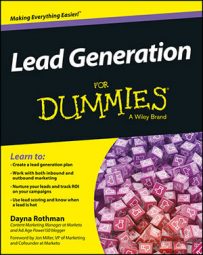Many marketers dismiss Facebook due to its perceived reputation as a personal social network. And although it may be true that Facebook is used to connect with family and friends, businesses can also tap into the huge value that Facebook offers. More than 800 million people use Facebook every day, so if you can show value for your followers, your lead-generation efforts can have a true network effect.
In order to become active on Facebook as a business, you need to create a Facebook Page for your company, if you haven't done so already. Your Facebook Page should include an About section where you can write about your company. Be sure to include an interesting cover image and a profile photo.
Facebook enables businesses to "have a face" and interact with leads and customers on a more personal basis. But because Facebook is such a widely used personal social network, businesses need to strike a real balance between offering content that is valuable for brand positioning and offering content that is fun and shareable.
Ask yourself two questions before posting content on Facebook:
Does this piece of content help our brand's likability?
Is this piece of content interesting, engaging, and useful?
Because of Facebook's News Feed algorithm, posting for the sake of posting because you aren't sure what message you want to convey can actually hurt your chances of being seen and followed. Facebook is constantly updating their platform and they continually try to improve the usability of News Feed. A couple of years ago, EdgeRank was all anyone talked about, but now it seems that EdgeRank is defunct.
Facebook has dropped the name EdgeRank and has created an even more complex algorithm. According to a recent Marketing Land article and interview with Facebook's engineering manager for News Feed ranking, "Facebook hasn't used the word (EdgeRank) internally for about two and a half years. That's when the company began employing a more complex ranking algorithm based on machine learning. The current algorithm doesn't have a catchy name, but it's clear that EdgeRank is a thing of the past."
But what does this algorithm do? It helps Facebook determine what gets displayed on a user's News Feed. In simple terms, if users or their friends are interacting with your company on a frequent basis, you show up more frequently on their News Feeds. If not, you get dropped and will not appear. Thus, you want to ensure that you are part of the virtuous cycle of showing up on News Feeds with interesting topics to share.
Because engagement is critical to the News Feed, if your content is not shareable and being interacted with, it simply won't show up. And if your content doesn't show up in the News Feed, well, you won't be getting many leads.
What do you have to keep in mind to stay relevant in Facebook's News Feed? Here are some important things to think about:
Affinity: How close is the relationship between the user and content?
Weight: What type of action was taken on the content? A comment might have more weight than a Like, and so on.
Decay: How current is the content?
Post types: What type of posts does a user typically interact with?
Hide post/spam: What type of posts does a user hide or mark as spam?
Clicking on ads: Does a user interact with ads?
Device considerations: Can the device a user is on handle certain types of content?
Story bumping: Is it worthwhile to give old posts new visibility if people are still interacting with them?

